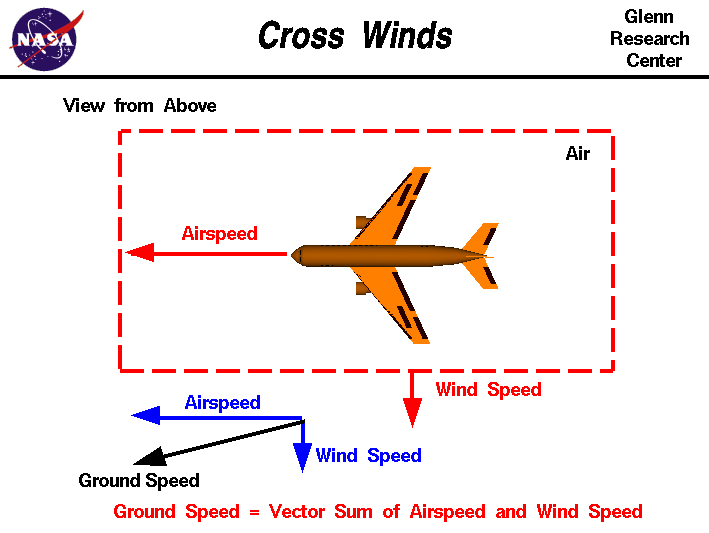
One of the most confusing concepts for young aerodynamicists is
the relative velocity between objects.
Aerodynamic forces
are generated by an object moving through the air, but the air itself can
also move.
Aerodynamic forces depends on the square of the velocity
between the object and the air. To properly define the velocity, it
is necessary to pick a fixed reference point and measure velocities
relative to the fixed point. In this slide, the reference point is
fixed on the ground, but it could just as
easily be fixed to the aircraft.
The air in which the aircraft flys can move in all three
directions. In this figure, we are only considering velocities which
occur perpendicular to the flight path but parallel to the ground
and are called cross winds.
The effect of wind along the flight path has been considered in the
previous slides. Updrafts and downdrafts
which occur perpendicular to the ground are described in another
slide. In this figure, we are viewing the aircraft from above and
have assumed that the wind is blowing at a constant velocity from
right to left as viewed from the cockpit.
The aircraft moves through the air at some velocity called the
airspeed. The air moves at some constant velocity called the
wind speed which is perpendicular to the airspeed.
The airspeed and the wind speed are both
vector quantities
having a magnitude and a direction.
The chief
effect of the cross wind is to deflect the flight path in the
direction of the wind.
The aerodynamic lift
force depends on the airspeed and is not related to a constant cross
wind. The cross wind simply adds another
vector component
to the ground speed
which affects the flight
trajectory.
The addition must be performed according to the rules for
vector addition.
The description given for this slide concerns only static
performance. This means that the wind is steady and the aircraft
is aligned along its flight path. Unsteady cross wind gusts
will introduce additional forces on the aircraft due to changes in
the angle of attack of the vertical stabilizer and, depending on the
cross-sectional shape of the fuselage, some changes in lift.
Additional forces can also be generated by yawing,
or turning, the aircraft along the flight path by using the rudder.
These effects are not discussed in this slide.
Activities:

Guided Tours
-
 Into the Wind:
Into the Wind:

Navigation ..

- Beginner's Guide Home Page
|
